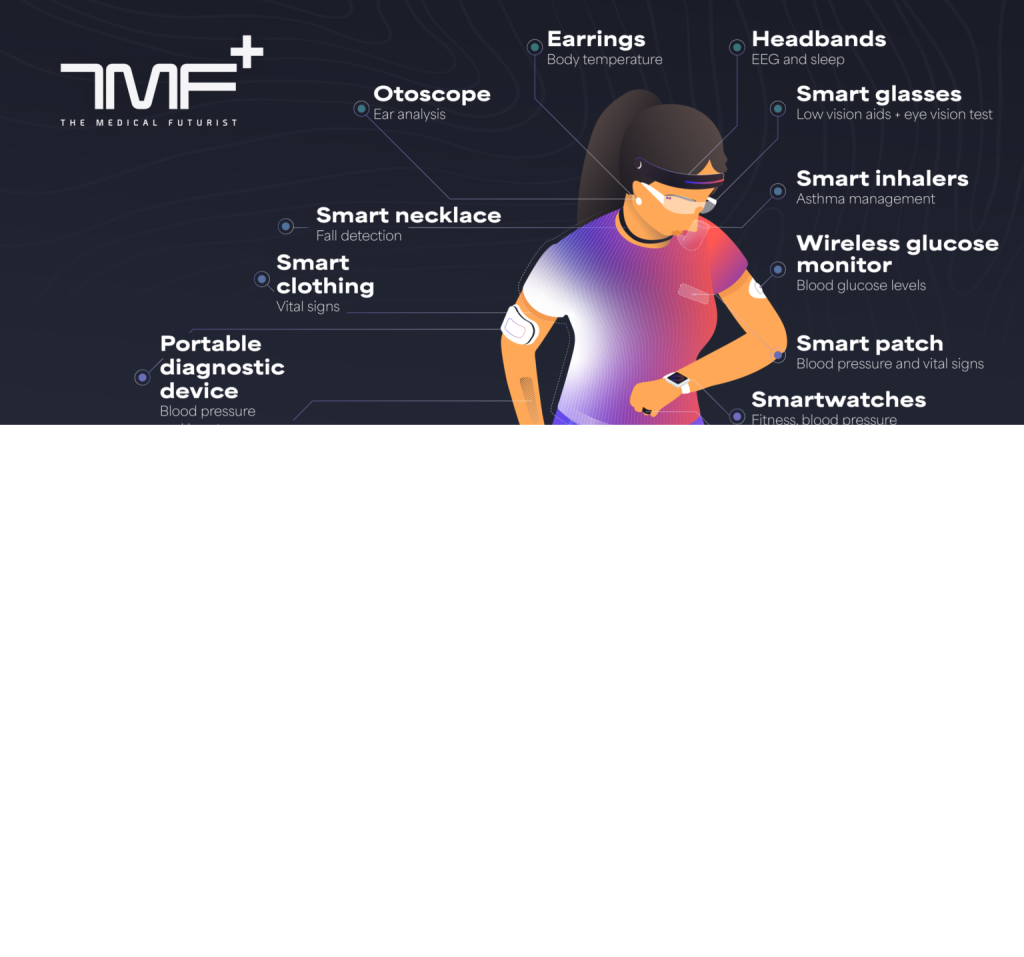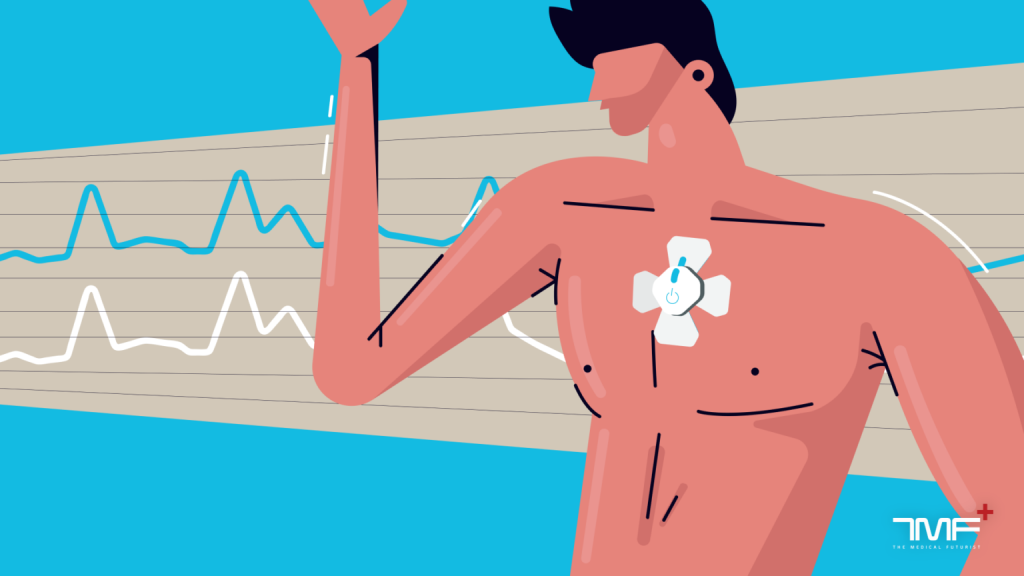Wearable health technology has moved far beyond step counters and fitness bands. Over the past decade, Dr. Bertalan Meskó, better known as The Medical Futurist, has tested more than 150 digital health devices, turning his life into a living laboratory. What’s striking is that the innovation never stops. Just when it feels like the market has covered everything, a new category emerges—such as smart earrings that measure body temperature. The world of wearables is expanding faster than ever, reshaping how we monitor, understand, and manage health.
Our latest overview highlights the wearable health tracker landscape, spanning 18 devices across 18 body parts. From headbands to smart socks, these innovations show how health tracking is becoming more personalized, accessible, and seamless.
Headbands: Monitoring Brain Activity and Sleep

Headbands equipped with EEG sensors go beyond standard wrist trackers by measuring brainwaves. Devices like Muse or Philips SmartSleep provide deeper insights into sleep cycles—light, deep, and REM—while also supporting meditation and focus training. Some even include smart alarms or audio features to enhance sleep quality.
While incredibly informative, comfort remains a challenge; wearing a headband overnight isn’t for everyone. Still, they offer valuable data for those interested in optimizing rest and mindfulness practices.
Smart Earrings: Stylish Temperature Monitors
Temperature-tracking earrings work like discreet thermometers, detecting subtle earlobe fluctuations throughout the day. These changes can reveal signs of stress, track fertility, or monitor activity. Still in development, they promise even broader features such as heart rate tracking and energy harvesting from movement. Small, stylish, and packed with potential, earrings could redefine wearable design.
Upper Arm Patches: Wireless Glucose Monitoring
Wireless glucose monitors are revolutionizing diabetes care by providing painless, continuous blood sugar insights. While essential for patients, even non-diabetic individuals can gain useful data during short test periods when guided by physicians.
However, continuous glucose monitoring isn’t meant to become a new obsession for healthy individuals. Used purposefully, it provides actionable insights, but for people with diabetes, access and affordability still vary greatly worldwide.
Smart Tattoos: Skin-Deep Health Tracking
Digital tattoos transform skin into a living laboratory. Acting like invisible minilabs, they can track blood pressure, hydration, or glucose levels through microneedles while sending real-time data to apps. They also double as security tools, unlocking phones or doors.
This futuristic approach could make health monitoring nearly invisible, eliminating bulky devices while making care more seamless.
Chest Patches: Vital Signs Made Simple

Chest-worn smart patches replace traditional cuffs and wires with slim, adhesive designs that monitor blood pressure and vital signs continuously. They deliver detailed cardiovascular reports, alerts, and long-term data for physicians.
Though not yet a full substitute for clinical devices, they offer convenience and personalized insights for proactive heart health management.
Belt Sensors: Stress and Fitness Monitoring
Developed by researchers at Florida Atlantic University, belt-based sensors measure advanced data like thoracic impedance and ECG rhythms. Designed to help detect early signs of heart failure, these waist-worn devices could prevent hospital readmissions through real-time alerts.
They’re a promising middle ground between invasive implants and surface-level trackers.
Smart Clothing: Fashion Meets Function
Smart textiles weave sensors into everyday garments, from yoga pants that correct posture to sports bras tracking breathing. Hospitals may one day use sensor-embedded shirts for continuous patient monitoring, replacing cumbersome wires.
Fashion is experimenting too—like Adobe’s Primrose dress showcased at New York Fashion Week—proving that health tech can blend seamlessly with style.
Smart Socks: Protecting Diabetic Feet
Diabetic patients face a high risk of foot ulcers, which can escalate into serious complications. Smart socks combat this by embedding temperature sensors in fabric. Early detection of inflammation allows patients and doctors to act before problems worsen, potentially saving lives and limbs.
Smart Shoe Soles: Fitness from the Ground Up
Smart insoles and shoes track steps, gait, and workout efficiency. While their current cost rivals high-end smartwatches, they offer unique potential since shoes are a natural data-collection platform. Over time, as technology matures, smart footwear could become as mainstream as wristbands.
Upper Arm Devices: Heart and Blood Pressure Checks
Portable devices like Withings BPM Core measure blood pressure, ECG, and even heart sounds from the upper arm. They make heart health monitoring easier and more accessible, bridging the gap between clinical checkups and everyday health tracking.
Smartwatches: The Powerhouse on Your Wrist
Smartwatches have evolved into comprehensive health hubs. Beyond steps and calories, they now monitor ECG, blood oxygen, atrial fibrillation, and sleep. Brands like Apple and Samsung continue pushing boundaries, making advanced features widely available.
While not replacements for doctors, smartwatches empower users to stay motivated, identify health trends, and share valuable data with physicians.
Smart Bracelets: Discreet Blood Pressure Tracking
Smart bracelets leverage photoplethysmography (PPG) sensors to continuously measure blood pressure. Lightweight and stylish, they’re less intrusive than traditional cuffs, offering real-time tracking for those who want constant insights into cardiovascular health.
Smart Rings: Compact but Powerful
Smart rings condense wellness tracking into a small, stylish form factor. They monitor heart rate, sleep, body temperature, and oxygen levels while keeping hands free.
Anticipation is high for the Samsung Galaxy Ring, rumored to feature ECG, sleep tracking, and contactless payments—potentially setting a new standard for wearable rings.
Smart Necklaces: Discreet Fall Detection
Once bulky, fall-detection devices have evolved into chic, jewelry-like smart necklaces. Targeted primarily at seniors, they detect falls and automatically alert caregivers.
As algorithms improve, these devices may soon integrate additional metrics, broadening their role in preventive health care.
Smart Glasses: Transforming Vision Care
Smart glasses assist users with low vision using cameras, AR, and magnification. They also pave the way for at-home eye exams through eye-tracking and self-guided tests, potentially improving access to vision care worldwide.
Devices like EyeQue Insight already showcase this potential, though clinical validation is ongoing.
Thumb Sensors: Continuous Oxygen Monitoring
Pulse oximeters have long been used for spot checks, but new thumb-worn devices provide continuous oxygen tracking throughout the day. This is especially valuable for athletes, patients with respiratory conditions, or those recovering from illness.
Such long-term data allows users and doctors to spot trends and intervene earlier.
Smart Inhalers: Smarter Asthma Management
Smart inhalers track medication usage, remind patients of doses, and analyze triggers through companion apps. They empower patients to stay on top of treatment while providing physicians with accurate adherence data.
For asthma patients, this could mean fewer flare-ups, better long-term control, and more personalized care.
In-Ear Sensors: Ear Health Made Simple
In-ear sensors like HearScope transform smartphones into diagnostic otoscopes, allowing individuals to capture videos of their ear canals. These can be shared with doctors for remote evaluations, reducing unnecessary clinic visits.
While not replacing in-person exams, they enhance telehealth and help parents monitor children’s ear health conveniently.
Frequently Asked Questions:
What are wearable health trackers?
Wearable health trackers are smart devices worn on different parts of the body to monitor health metrics like heart rate, sleep, oxygen levels, and more.
How accurate are wearable health trackers?
Accuracy varies by device and brand. While most provide reliable trends, they shouldn’t replace professional medical tests. They work best as complementary tools for wellness and early detection.
Which body parts can wearable devices monitor?
Today’s wearables can be worn on the head, ears, arms, chest, waist, fingers, feet, and even skin—covering 18 unique body parts with specialized functions.
Can wearable health trackers replace doctor visits?
No, they can’t fully replace medical care. These devices are designed to provide continuous insights and trends, which can help you and your doctor make better health decisions.
What are the benefits of using wearable health trackers?
Key benefits include real-time health monitoring, early warning for potential issues, motivation to stay active, improved chronic disease management, and personalized wellness insights.
Are wearable devices safe to use daily?
Yes, most are safe for everyday use. However, always choose FDA-approved or medically validated devices if you’re using them for serious health monitoring.
How do wearable trackers help people with chronic conditions?
They provide continuous data for conditions like diabetes, asthma, and heart disease. For example, smart patches track glucose levels, while smart inhalers monitor asthma medication use.
Conclusion
Wearable health technology is no longer just a trend—it’s a revolution shaping the future of healthcare. From smart rings and socks to digital tattoos and inhalers, these devices are transforming how we monitor, prevent, and manage health conditions. Covering 18 different parts of the body, they offer continuous insights, empower individuals to take charge of their wellness, and support doctors with valuable real-time data.



